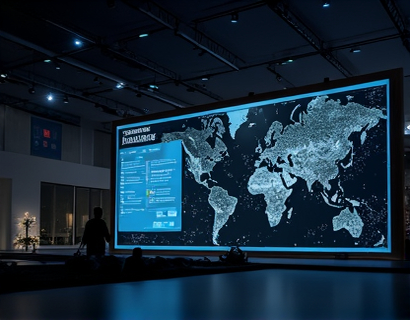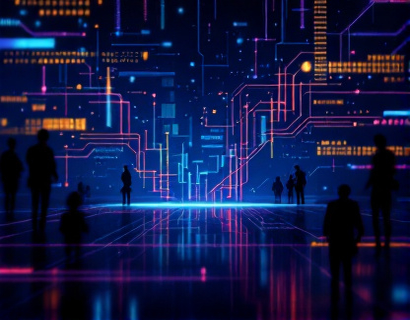Next-Gen QR Code Technology: Revolutionizing Business and Social Media Engagement for Modern Enterprises
In the rapidly evolving digital landscape, businesses and social media managers are constantly seeking innovative solutions to enhance engagement and streamline interactions with their audience. One such technology that has emerged as a game-changer is next-generation QR code technology. This advanced form of QR codes is not just an improvement over the traditional version but a transformative tool that offers customizable and intuitive features, significantly enhancing information sharing and customer interaction. For modern enterprises, integrating next-gen QR codes into their digital strategies can be pivotal in boosting their online presence and fostering deeper connections with their audience.
The evolution of QR codes from simple black and white squares to sophisticated next-gen versions marks a significant milestone in digital engagement. Next-gen QR codes, often referred to as enhanced or intelligent QR codes, incorporate advanced features that traditional QR codes lack. These include the ability to store more data, support multiple formats, and integrate seamlessly with various digital platforms. This evolution is driven by the increasing demand for more interactive and efficient ways to share information and engage with consumers.
Enhanced Data Storage Capabilities
One of the most notable advancements in next-gen QR codes is their enhanced data storage capabilities. Unlike traditional QR codes that can store up to 7,089 numeric characters or 4,296 alphanumeric characters, next-gen QR codes can hold significantly more data. This increased capacity allows businesses to include detailed information such as comprehensive product descriptions, extensive contact details, and even multimedia content like videos and audio clips. This feature is particularly beneficial for brands looking to provide rich and informative experiences to their customers without overwhelming them with multiple links or pages.
For instance, a retail brand can embed a next-gen QR code on a product label that, when scanned, not only directs the customer to the product's webpage but also provides a detailed video demonstration, customer reviews, and a direct link to purchase the item. This holistic approach not only enhances the customer's shopping experience but also increases the likelihood of conversion.
Customization and Brand Integration
Next-gen QR codes offer unparalleled customization options, allowing businesses to align these codes with their brand identity. Customizable colors, shapes, and logos can be incorporated into the QR code design, making them visually appealing and memorable. This level of personalization helps in building brand recognition and trust. When a QR code reflects the brand's aesthetic, it creates a cohesive and professional image, reinforcing the brand's message and values.
For example, a luxury fashion brand can design a QR code in their signature color and shape, ensuring that it stands out and aligns perfectly with their high-end image. When customers scan the code, they are greeted with a sophisticated landing page that matches the brand's overall look and feel, enhancing the premium experience.
Multi-Format Support
Another significant advantage of next-gen QR codes is their support for multiple formats. These codes can link to various types of content and platforms, including websites, social media profiles, email addresses, and even geolocations. This versatility ensures that businesses can direct users to the most relevant and engaging content based on their needs and preferences.
For instance, a travel agency can use next-gen QR codes to direct customers to their website for booking flights, to their Facebook page for travel tips, and to a specific destination's geolocation for in-depth travel guides. This multi-faceted approach not only streamlines the user experience but also maximizes the potential for engagement and conversion.
Seamless Integration with Digital Platforms
Next-gen QR codes are designed to integrate smoothly with a wide range of digital platforms, making them a versatile tool for modern businesses. They can be easily embedded into websites, social media posts, email campaigns, and physical marketing materials. This seamless integration ensures a consistent and cohesive user experience across all touchpoints, enhancing overall engagement and customer satisfaction.
For example, a tech company can embed next-gen QR codes in their blog posts to link directly to product demos or customer support pages. When users scan these codes, they are immediately provided with the relevant information, reducing bounce rates and increasing the chances of converting visitors into customers.
Improved User Experience and Interaction
The primary goal of next-gen QR codes is to improve user experience and interaction. By providing quick and easy access to valuable content, these codes reduce friction and enhance the overall customer journey. The instantaneous nature of QR code scanning means that users can quickly obtain the information they need without the hassle of typing URLs or searching for links.
Moreover, the interactive nature of next-gen QR codes encourages active participation from users. For instance, a brand can create a QR code that, when scanned, triggers a quiz or a survey. This not only engages the user but also provides the brand with valuable insights into customer preferences and behaviors. Such data can be used to refine marketing strategies and improve product offerings.
Boosting Social Media Engagement
In the realm of social media, next-gen QR codes serve as a powerful tool to boost engagement and interaction. By linking to specific social media content, businesses can drive traffic to their profiles and encourage users to interact with their posts. This direct linkage makes it easier for followers to engage with the content, share it with their networks, and become more involved with the brand.
For example, a music artist can include a next-gen QR code in their concert flyers that links directly to their latest music video on YouTube. When fans scan the code, they are taken straight to the video, increasing the likelihood of views, shares, and likes. This streamlined process not only boosts engagement but also helps in building a loyal fan base.
Enhancing Customer Loyalty and Retention
The use of next-gen QR codes can significantly contribute to customer loyalty and retention. By providing valuable and relevant content through these codes, businesses can create memorable experiences that keep customers coming back. The convenience and immediacy of QR code interactions make it easier for customers to return to a brand for more information or to complete a purchase.
Additionally, the data collected from QR code scans can be used to personalize future interactions and offers. For instance, a retailer can track which products customers are most interested in based on the QR codes they scan, and send targeted promotional emails or offers. This personalized approach not only enhances the customer experience but also increases the chances of repeat purchases.
Challenges and Considerations
While next-gen QR code technology offers numerous benefits, there are also challenges and considerations that businesses should be aware of. One key aspect is ensuring that the QR codes are scannable and functional across different devices and environments. Poor quality or low-contrast codes can lead to scanning failures, frustrating users and undermining the intended experience.
Another consideration is the need for clear instructions and visibility. QR codes should be placed in prominent locations and accompanied by clear instructions on how to scan them. This ensures that users are aware of the benefit and know how to interact with the code effectively.
Future Trends and Innovations
The future of next-gen QR codes is promising, with ongoing innovations set to further enhance their capabilities and applications. One area of development is the integration of augmented reality (AR) features, where scanning a QR code triggers an AR experience. This can range from virtual product demonstrations to interactive games and experiences, providing brands with new ways to engage and entertain their audience.
Another trend is the incorporation of blockchain technology, which can enhance the security and authenticity of QR codes. This is particularly relevant for industries such as luxury goods and pharmaceuticals, where verifying the authenticity of products is crucial. By embedding blockchain data within the QR code, businesses can ensure that customers receive genuine products and build trust through transparency.
Conclusion
Next-gen QR code technology represents a significant leap forward in digital engagement for modern enterprises. With their enhanced data storage, customization options, multi-format support, and seamless integration, these codes offer a powerful tool for businesses to connect with their audience more effectively. By leveraging next-gen QR codes, brands can create richer, more interactive experiences that drive engagement, loyalty, and growth. As the technology continues to evolve, businesses that embrace these innovations will be well-positioned to thrive in the dynamic digital landscape.










































